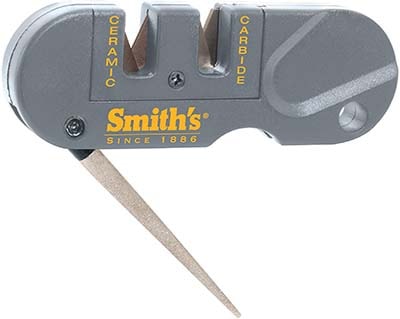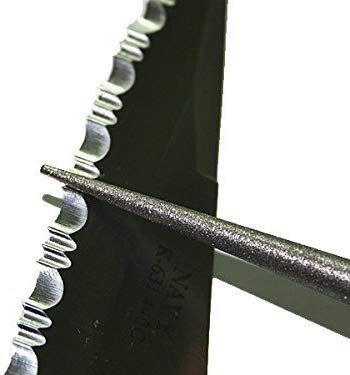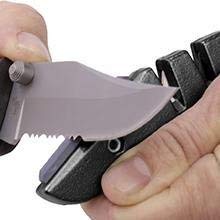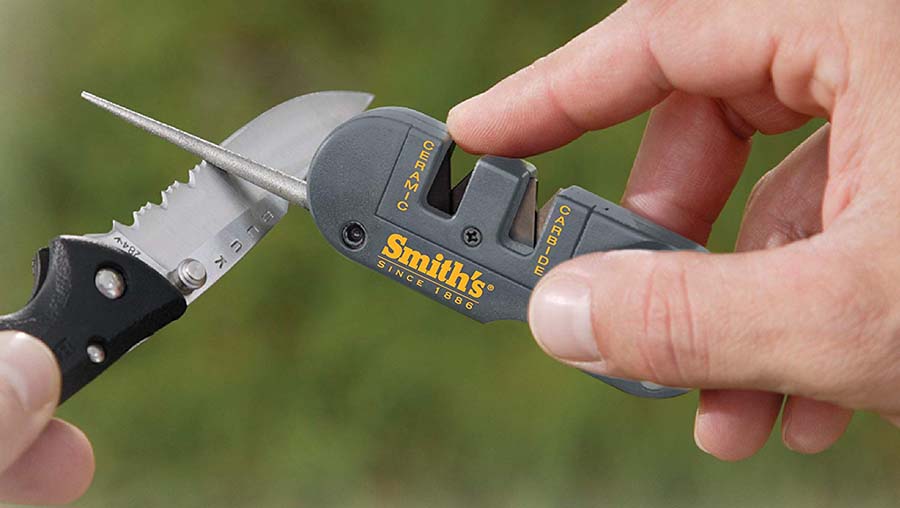What good is a knife that can’t cut? That’s about as useless as a hammer with no handle. However, hammers traditionally have one universal shape, while knives come in a plethora of shapes and customizations.
Thankfully there are ways to sharpen outdoor knives or kitchen knives of all types, which helps restore their usefulness over time. Today, I’ll be educating you on serrated knives, as well as the best tool to use in order to maintain your blade’s sharpness.
What’s A Serrated Knife?
Before learning how to sharpen a serrated knife, one must take into account what makes a serrated knife different from numerous other blades.

When I say serrated knife you must understand that it can be a serrated fixed blade knife for outdoor use or also a serrated pocket knife or serrated kitchen knife for everyday use.
Also, a serrated knife does not mean that the blade of the knife will always be fully serrated, it can also be a half or partially serrated blade.

A serrated knife features a set of “teeth” that looks just as one would imagine. This blade is specifically made for harder or flexible materials and foods, such as rope, leather, bone, wood, thick meat, or a loaf of bread.
The teeth on this serrated blade are used in a sawing motion to cut through tougher foods, but can also slice through tender substances cleanly as well.
In some situations, a serrated blade can even cut cleaner and more efficiently than a smooth blade, as the teeth can catch and grip unto surfaces.
Without a doubt, a serrated blade can be useful in many ways, but can also be intimidating to sharpen due to the large row of teeth along the blade. No worries, sharpening a serrated knife is easier than it looks.
The Sharpening Rod Or Tool
One of the most common knife sharpeners is the steel sharpening rod. This tool is used to help file and sharpen the serrations along the blade of a knife. This sharpener is effectively designed to be used for serrated knives.

The sharpening rod files and sharpens each individual tooth/gullet along the blade, restoring the sharpness of the knife with relative ease. Let me take you through the easiest steps of sharpening and restoring your blade.
The 6 Easy Steps
Step-1: Start off by placing your sharpening rod unto the bevel edge of your blade. The bevel edge is the front of your blade with the row of teeth formed along its edge. (This is the only part of the blade that should be sharpened with the tool.)

Step-2: Place the rod into an individual tooth, otherwise known as the gullet, of your blade. You will have to repeat all of these steps for each individual gullet.
Step-3: Hold your blade at a sharp (no pun intended) angle in order to run the sharpening rod smoothly along with the serrations of the blade.

Step-4: Use short, concentrated strokes as you run the rod back and forth along the groove of each gullet. Use around 3-4 strokes at most before moving along to the next gullet.
Step-5: File away from your body to avoid potential harm.
Step-6: Remove the excess burr that may pile up from filing your blade, in a safe manner.
While some serrated knives have teeth that form along the entirety of the bevel edge of the blade, some tactical knives only have partial serrations. For those with a partially serrated blade, a few extra steps are required in order to sharpen the remainder of your knife.

Additional sharpening tools such as Whetstone Knife stones, or other knife sharpening systems can be used to sharpen the remaining flat portion of your blade. Using the sharpening rod is usually not the most effective method to use for the straight portions of the bevel edge of your blade.
How Much Are Sharpening Rods?
Many sharpening rods are inexpensive, costing roughly around $10-$20 dollars at most. These tools can be found at local stores and supermarkets, and are a great tool to have around in case your blade becomes dull.

The benefit of these sharpening rods is its easy usage, comfortable handling, durability, and cheap price. Not only you can sharpen your serrated edge knife in a flash, but it also won’t cost you too much in expenses.
Final Words
Overall, sharpening your serrated knife is much easier than it looks. Although at first, it can be intimidating to see the numerous teeth along the blade, sharpening each tooth/gullet isn’t too complicated or time-consuming. A sharpening rod is an inexpensive tool that can help restore the sharpness of your blade when it goes dull. I hope you found this guide useful, and sharpen your knife to the best of your abilities!
